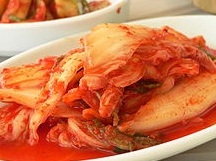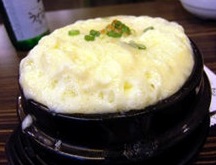This year, for the first autumn birthday, we took the family and a guest to a nearby Korean barbeque that has gotten some great reviews. Honey Pig really is a small slice of South Korea tucked into the DC suburbs. From its dark and industrial-styled interior to its straightforward, unembellished service and the thumping pop on the sound system it feels like stepping into another country when one enters this restaurant. Tucked into a small shopping center the lines to get in can sometime wrap around the building. It’s mostly Asian and Asian-American clientele are also a credit to the authenticity of the food.
When we visited, we were lucky enough to just walk in and be seated at a nearby table with a built-in gas range to cook our dishes on. After ordering from their simple but sufficient menu, we started with a nicely variant banchan consisting of Kimchi of both Napa cabbage and cucumber; a green salad with a spicy soy dressing; a delicate lightly sweet radish preparation that resembled pickled ginger but that had a light, refreshing flavor (Musaengchae); a spinach dressed with sesame oil, garlic and soy sauce (Siegumuchi namul); Kongnamul, the parboiled bean sprouts with sesame oil and something I’ve never seen before and don’t know the name, but it was sort of a Korean cole-slaw with what tasted like a dilute mayonnaise dressing. I’m going to find out more about this dish and wonder if it is a Korean-American creation. In addition to the seven banchan, they served a Gyeran Jiim of light and frothy steamed eggs in a hot pot that was heavenly. My husband and I split an ice-cold bottle of Bek-Se-Ju which if you’ve never had it is an herbed rice wine that tastes more like a slightly thickened chamomile tea than alcohol. It also contains the adaptogen schizandra that I’ve written about in other posts.

Utensils (sujeo) consisted of the Korean long-handled spoon and chop sticks – which for the kids still learning how to use them were connected at the top to make it easier for them to pick items up. Fresh lettuce leaves were also available for those wishing to wrap portions of their meals. We enjoyed the banchan and cajoled the kids into trying some while the wait staff prepared and started to cook our meals. The girls shared long looks when the waitress came over with a pair of industrial scissors to cut down the bits of cooking meat into bite-size pieces. Each dish was also cooked with plenty of thinly sliced garlic to heighten the flavor of the grilled dishes and there was steamed rice all round.
My husband and I shared a delicious pork and octopus dish sautéed with onions and in red chili sauce (gochuchang), the girls shared a fiery chicken dish also cooked in red chili sauce and my son with his more delicate taste went for a marinated beef bulgogi that was gently flavored with a light soy-based sauce. My son also ordered Doen-Jang-JJigae – a traditional soup that was gently flavored with on-the-bone beef and plenty of greens and onions, and we all sampled the Kimchi stew.

I have mostly praise for Honey Pig, if there were issues, the octopus was a little tough – which could be easily remedied by cooking it less and I’d like to see a bit less red-chili sauce on the dishes – which were in my opinion, swimming in it. Next time we go – and there will be a next time – we’ll sample the more traditional galbi or short ribs and samgyeopsal – unsalted pork belly (bacon).
For those living in of visiting the DC area, this restaurant is a casual taste of the food and food-culture of Korean peninsula and manages to be both funky and family friendly (and baby friendly based on the presence of the Korean baby at the table next to us) at the same time. I recommend it as the best suburban Korean BBQ I’ve been to so far, and hope that as their success builds, they begin to offer an even more varied menu. Always, I hope it remains a secret door into Korean food culture that one can experience without the thirteen hour flight time. (Words by Laura Kelley; Photo of Honey Pig Restaurant by the owner; Photo of Kimchi and Steamed Eggs from Wikimedia).

